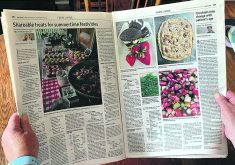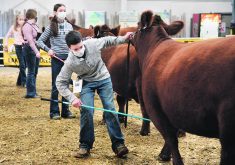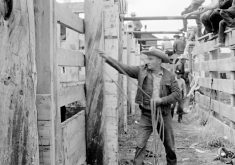Farm families in 2010 were adapting to changes as farms and farm implements were becoming larger and more technical, marketing methods were changing and there was a growing disconnect between consumers and producers.
Computer technology and internet access were becoming essential to monitor the information generated on new farm equipment and for farmers to market their products, but the internet and media were bombarding consumers with myths and negative perceptions associated with modern agriculture.
The economy of scale was one reason farms were getting larger. According to Canadian Grain Commission statistics, in 1962 Saskatchewan had 2,878 grain elevators. In 2019 there were only 181.
Read Also

Fuel rebate rule change will affect taxes and AgriStability
The federal government recently announced updates to the fuel rebates that farmers have been receiving since 2019-20.
For efficiency in hauling longer distances, large semi-trailer trucks were needed. Tractors and seeding and harvesting equipment were all getting larger so more land could be covered in less time more efficiently.
Maintaining family farms was another reason to increase farm size. Humphrey and Terry Banack had over 100 years of family farming history in Alberta. They purchased the farm his grandfather homesteaded in 1906, near Round Hill, Alta. Later they also bought the farm where Terry was raised just a few kilometres south, at Kelsey.
“By purchasing this farm, it was saying we treasure and respect the family farm and believe it should stay in the family,” Humphrey said in a Jan. 14, 2010, article.
Severe storms, multiple tornados and unsettled weather conditions caused excessive moisture across the Prairies in 2010. In Saskatchewan, by early July, 72 rural municipalities had declared disasters.
Gerry Kuebrecht, reeve of the RM of Wallace, said rain that swamped Yorkton’s downtown drained through the already saturated RM. Large lakes had formed where fields should have been.
“I’ve been farming 46 years, and this is the first year I can say I didn’t plant a full crop,” the Rhein area farmer stated.
The Canadian government created the Canadian Wheat Board in 1935. For much of its history, it was the sole buyer and seller of prairie wheat and barley destined for export from Canada or for human consumption in Canada.
Referred to as “single desk” marketing, under this model it was illegal for farmers to sell their grain to anyone other than the CWB. Following a change in government policy, the single-desk model was discontinued in August 2012, and the CWB became a voluntary marketing organization.

Prairie farmers could then sell their grain to any buyer, including the CWB. This freedom brought a need for farmers to actively seek markets for all their products, which required more time and increased knowledge of how to access those markets.
A disconnection between consumers and producers was being recognized due in part to fewer people directly involved in farming and most consumers living a distance from farms.
Farm & Food Care Saskatchewan recognized the need to inform food writers, food bloggers, chefs, photographers and post-secondary educators involved in the culinary arts so they in turn could share what they learned with their audiences.
In July 2017, 20 visitors from across Canada and as far south as Nashville, Tennessee, were hosted by Farm & Food Care for a Farm to Fork tour of farms and food processing operations in the Saskatoon area. Clinton Monchuk, executive director and a farmer from near Lanigan, Sask., stated “there is so much misinformation out there about food and how it is produced, so to actually have these food influencers come and see a farm is very important.”
They toured farms, saw the equipment and received explanations on how and why it is used. There were opportunities for visitors to speak with farmers and ask questions about herbicides, genetically modified crops and the economics of primary food production.
The tour also included a gourmet-style meal highlighting locally produced foods.
Lacey McCrae, 27, a semi-finalist with the Canadian Cattlemen Association’s Young Leaders program, raised Black Angus cattle and crops with her husband near Vermilion, Alta. She wrote articles and blogs showcasing what farmers do and why they do it.
“I see advocating as a very necessary part of going forward in agriculture,” she said. “It seems we have an urban culture that is aggressive, and we need to work harder at sharing our personal stories, make our ranch have a personal face.”
McCrae cited her own experience with cattle in distress.
“I wish we could get this message out about how much we deeply care about our animals,” she said. “I’m willing to be half submerged in a watering bowl in -35C with a howling wind just to try to save the life of one of my animals.”
The Federated Women’s Institutes of Canada celebrated its 100th anniversary Feb. 19, 2019. An umbrella organization for Women’s Institutes in Canada, its aim was to help empower rural women to make a difference for their families and communities by speaking as one voice at the national level.
There were 660 branches in 10 provinces, with about half of the 7,000 members in Ontario in 2019.
Membership was declining and “as with other organizations, it is difficult to attract younger members,” stated president Joan Holthe. Women say they just don’t have time to join anymore.
Women are not as isolated as they were a century ago, but Holthe said the Women’s Institute continues to address societal problems with a hands-on approach, which she credits for helping many women, including herself.
“One hundred years later, we still have the same issues of food safety, improving our schools and communities.”
Wendy Hamilton, executive director, said “the internet has been both a blessing and curse.” With the advent of social media, particularly in the past five years, there are different modes of communication, which have allowed for increased education and access.
Women’s Institutes are not alone in trying to adapt to a new world, Hamilton explained, “whether it be not-for-profit, volunteer or charitable, many sectors are struggling with the changes in what people are looking for regarding their efforts, involvement and how they want to get engaged.”
Betty Ann Deobald, one of The Western Producer’s TEAM Resources columnists, will write a monthly column for the next year examining rural life in each decade of the last century.















